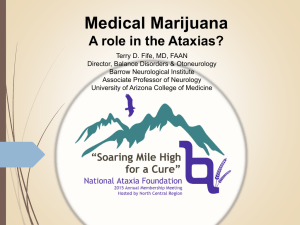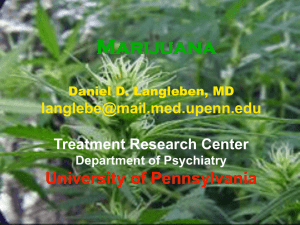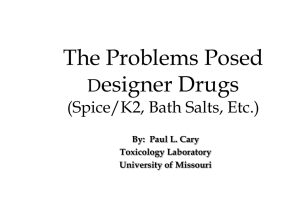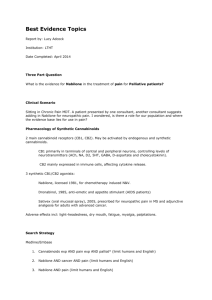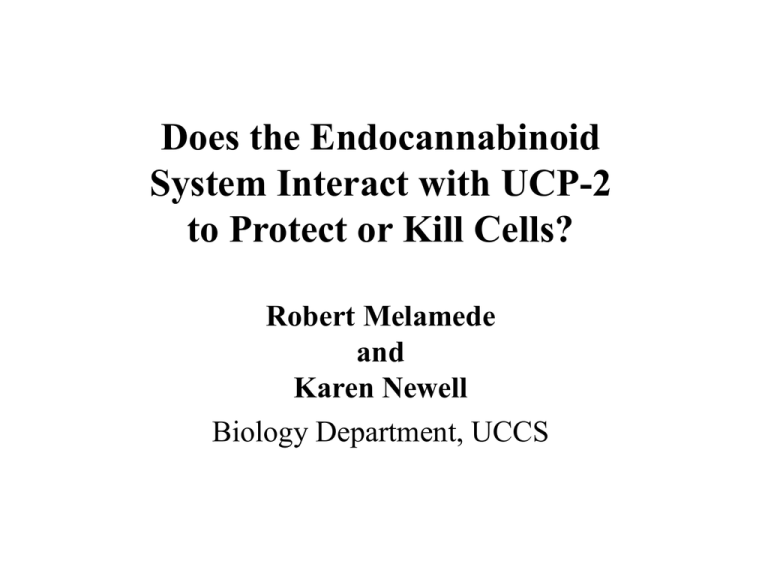
Does the Endocannabinoid
System Interact with UCP-2
to Protect or Kill Cells?
Robert Melamede
and
Karen Newell
Biology Department, UCCS
Abstract
While marijuana has been used extensively for numerous medical
applications over thousands of years, it was with the recent discovery of
cannabinoid receptors and their natural ligands (endocannabinoids) that a
modern scientific basis for medical use was established. Interestingly, current
research not only provides support for historical medical applications, but as
this field explodes with a continuous flood of new discoveries, many new
possibilities are revealed. The endocannabinoid system first appeared in the
biosphere 600 million years ago. At that time, living systems were limited to
simple multi-cellular organisms such as hydra. It is thought that the
endocannabinoids were involved in feeding behavior.
Due to it’s important role in energy acquisition, the endocannabinoid
system was destined to play an ever expanding role in the evolving biosphere.
Today we know that these compounds regulate basic homeostatic mechanisms.
Their effects range from the reproduction of organisms and cells to their death.
Cannabinoids regulate homeostasis of
the immune, endocrine, cardiovascular, digestive, excretory, nervous and
reproductive systems. Their predominant, but not exclusive mechanism of action is
through G-coupled receptors, CB1 receptors are found mainly in the plasma
membrane of nerve tissue, and CB2 receptor is found in immunological cells.
Depending on the tissue type, its’ condition, and the dose and type of cannabinoids
used, these compounds can cause or prevent cell death, replication or
differentiation.
Most disease states can be traced back to whether the right cells lived or die. On
the one hand, cannabinoids have been shown to selectively kill certain tumor cells
and on the other, they protect neurons and associated cells from damage-induced
cell death. We have discovered a basic metabolic mechanism that involves the ucp2 protein as a basic regulator of lipid catabolism, which in turn has been shown to
have a profound effect on the susceptibility of cells to killing agents that include
the immune system. The underlying mechanism by which ucp-2 inhibits cell death
appears to be tightly linked to its ability to protect cells from free radical induced
damages. Interestingly, cannabinoids can also protect cells, especially those of the
nervous system, from dying by free radical mechanisms. A possible
link between the cannabinoids system and ucp-2 is also suggested by the fact that
the endocannabinoids are all lipid products. We would like to examine the roles
that cannabinoids play in ucp-2 knockout mice as compared to the wildtype mice
with respect to protecting damaged nerve cells from dying. Similarly, we would
like to investigate how damaging agents affect ucp-2 activity in mice that are
knocked out for the CB1 and CB2 receptors.
A significant body of literature underscores the need for defining a possible
relationship between the cannabinoids and ucp-2. Endocannabinoids are part of
how organisms attempt to protect nerve cells from damage caused by
ischemia/reperfusion injury as well as from trauma. Damage caused by both of
these insults have a free radical component and are sources of neuronal death that
may occur during childbirth. Since endocannabinoids are neuro protective and are
found in mothers milk, they may function defensively rather than acting simply as
feeding stimulants. The molecular mechanism by which cannabinoids afford
protection from free radical induced cell death remains unknown. Uncovering the
relationship between cannabinoids and ucp-2 may provide some answers.
Endocannabinoid levels are increased in response to head injury, where they
minimized secondary effects that are responsible for amplifying the primary
damage.
The protective affects that cannabinoids afford the nervous system seem to result
from the antioxidant activities.
Cannabinoids can protect or kill nerve tissue as evidenced by their ability to kill
glioma (see below) and other types of cancers including some forms of breast and
prostate cancers, pheochromocytoma, leukemia and lymphoma.
UCP-2 Protects Cells From Free Radical Damage
Cells of respiring organisms need oxygen to form of ATP by oxidative phosphorylation. The
passage of electrons to oxygen, the terminal electron acceptor, productions free radicals as a
side product.
Free radicals are thought to be causative agents in age related diseases that include
autoimmune, cardiovascular and neurological diseases, cancer and aging itself.
Free radical production is enhanced when cellular energy flow is perturbed.
Cellular metabolism minimizes free radical damage by increasing the ratio of
lipid/carbohydrate fuel that is used for energy production. By increasing mitochondrial
ucp-2 activity, cells increase this ratio.
Theoretical Foundations
The relationships of flow dependant structures, as defined by Nobel Laureate Illya
Prigogine, to living systems has been most clearly demonstrated for glycolysis.
Recently, an apparent role of traveling metabolic waves in oxidant release by living
neutrophils has been demonstrated. These observations naturally suggest a link
between glycolytic oscillatory behavior and lipid metabolism that would provide a
new framework from which to view the dynamic balance between mitochondrial
coupling and uncoupling. Our efforts to explore possible relationships between
UCP-2 and the endocannabinoid system are underscored by the involvement of
cannabinoids in oscillatory biological phenomena such as sleep, hunger, body
temperature and the menstrual cycle. To learn more about dissipative structures
and living system please visit our companion poster Modeling Living Systems Based on Open System Far From Equilibrium
Thermodynamic
Research Plan
We will look for links between UCP-2 and the endocannabinoid system by
measuring the effects of cannabinoids agonists and antagonists on cell lines and
animals that have well defined phenotypes and genotypes with respect to UCP-2
activity.
We will examine the effects of cannabinoids on L1210 and L1210 DDP pre-B
mouse cell lines whose mitochondria are relatively coupled or uncoupled
respectively (Figure 1). These cells cause leukemia when injected into mice. We
will inject these cells into wildtype and UCP-2 knockout mice +/- cannabinoids.
Since it has been demonstrated that cannabinoids kill certain leukemia cells, these
cell and mouse lines provide an ideal starting point for these investigations.
Figure 2 demonstrates that both cell lines have CB1 but not CB2 receptors.
The mitochondria of L1210 cells have a higher membrane potential and
are more coupled that L1210/DDP cells.
L1210 and L1210/DDP cells express CB1, but not CB2 receptor genes
Possible Relationships of Cannabinoids and Uncoupling to Cognitive
Dysfunction?
Do endocannabinoids in mother’s milk play a role in protecting newborns from the
oxygen surge that occurs when they begin to breath?
Might the consequences of birth related neurological injury resulting from oxygen
deprivation and reperfusion be minimized by appropriate administration of cannabinoids,
compounds that promote their synthesis, or compounds that inhibit their breakdown?
Is the reduction in Alzheimer’s disease that is associated with the use of Aspirin and
other NSAIDS due to an in increase endocannabinoid levels which are in part metabolized
by COX?
Might the demonstrated role of cannabinoids in promoting “newness” facilitate the
learning of compensatory behaviors when required by neurological injury?
What might be the role of UCP-2 in any of the above?
Consciousness
Multicellularity Tissues,
Organs,
Immune, nervous, endocrine
systems
Life
Basic Cellular Metabolism and
Transport
Precellular, Prebiotic interacting dissipative
Structures
Multiple organizational levels are tied together through the flow of entropic terms
often forming flow dependant dissipative structures. Our computational model
will describe the forces and flows that are required to effect change on any level by
manipulating the forces and flows of other levels. The cannabinoid system
regulates homeostasis of the top 3 levels.
Ischemia/Reperfusion
A common cause of nerve cell death/impairment, and the associated biological
consequences, is ischemia/reperfusion.
Most tissues are susceptible to ischemia/reperfusion damage that occurs by
mechanisms involving free radical production.
Neuronal tissue is very sensitive to ischemia/reperfusion damage that typically results
from a variety of causes at different stages of life.
Oxygen deprivation during childbirth
Head injuries through out life
Stroke and cardiovascular disease late in life
Facts about Cannabinoids
While most people are aware of possible medical uses for external cannabinoids
(marijuana), most people do not know about the endocannabinoids that control
their bodies.
Endocannabinoids are marijuana-like compounds that are ligands for the
cannabinoids receptors (CB1-neurological, CB2-immunological and vanniloid).
They are found in, and produced by our bodies.
The activity of the cannabinoid system includes the synthesis of ligands,
cannabinoids receptors, and enzymatic processes for their degradation.
Neurologically, CB1 receptors and their ligands function by a novel mechanism.
The ligands move via retrograde transmission across the synaptic cleft where they
reduce the polarization of the presynaptic membrane after engaging the G-protein
coupled cannabinoids receptors.
Cannabinoids Regulate Homeostasis
High Level Coordination
1. consciousness
2. learning
3. appetite
4. body temperature
5. pain
6. sleep
7. Sex
Controlling Systems
1.1. nervous
2.2. immune
3. endocrine
Effector systems
1. digestive
2. respiratory
3. excretory
4. cardiovascular
5. reproductive
Related Diseases
1. Cancer
2. Immunological Diseases
1. a. Autoimmune
2. b. Asthma
3. Neurological Diseases
a. Parkinsons Disease
4. Cardiovascular Disease
5. Aging


